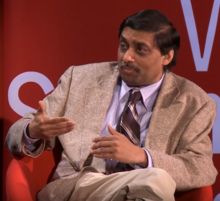| Samir D. Mathur | |
|---|---|
 Prof. Samir Mathur Prof. Samir Mathur | |
| Born | Samir Dayal Mathur Karur, Tamil Nadu, India |
| Alma mater | IIT Kanpur (M.S., 1981) TIFR (Ph.D., 1987) |
| Known for | Fuzzball (string theory) Contributions to: String Theory AdS/CFT Black hole information paradox |
| Scientific career | |
| Fields | Physics |
| Institutions | Ohio State University MIT |
Samir Dayal Mathur is a theoretical physicist who specializes in string theory and black hole physics.
Career
Teaching
Mathur is a professor in the Department of Physics at Ohio State University and a member of the University's High Energy Theory Group. He was a faculty member at Massachusetts Institute of Technology from 1991–99 and held postdoctoral positions at Harvard University and the Tata Institute of Fundamental Research.
Research
Mathur's research is focused on string theory, black holes, the AdS/CFT correspondence, and cosmology. He is best known for developing the Fuzzball conjecture as a resolution of the black hole information paradox. The Fuzzball conjecture asserts that the fundamental description of black holes is given by a quantum bound state of matter which has the same size as the corresponding classical black hole. This quantum bound state replaces the event horizon and singularity, and the classical black hole metric is claimed to be an approximate effective description.
In 2009 Mathur published a strong version of the black hole information paradox, strengthening Stephen Hawking's original version by demonstrating that small local corrections to Hawking's semiclassical analysis cannot restore unitarity. This result was obtained by applying Strong Subadditivity of Quantum Entropy to the evaporation of Hawking radiation. This led to a renewed interest in the information paradox and the development of the 2012 black hole firewall paradox.
References
- "Faculty information sheet". The Ohio State University. Archived from the original on 2015-04-04. Retrieved 2015-03-29.
{{cite journal}}: Cite journal requires|journal=(help) - Samir D. Mathur (2005). "The Fuzzball proposal for black holes: An Elementary review". Fortschr. Phys. 53 (7–8): 793–827. arXiv:hep-th/0502050. Bibcode:2005ForPh..53..793M. doi:10.1002/prop.200410203. S2CID 15083147.
- Samir D. Mathur (2012). "Black Holes and Beyond". Annals of Physics. 327 (11): 2760. arXiv:1205.0776. Bibcode:2012AnPhy.327.2760M. doi:10.1016/j.aop.2012.05.001. S2CID 119198601.
- ^ Samir D. Mathur (2009). "The Information paradox: A Pedagogical introduction". Class. Quantum Grav. 26 (22): 224001. arXiv:0909.1038. Bibcode:2009CQGra..26v4001M. doi:10.1088/0264-9381/26/22/224001. S2CID 18878424.
- Jennifer Ouellette, "The Fuzzball Fix for a Black Hole Paradox", Quanta magazine, June 23, 2015. https://www.quantamagazine.org/how-fuzzballs-solve-the-black-hole-firewall-paradox-20150623/
- Chowdhury Borun D., Puhm Andrea (2013). "Decoherence and the fate of an infalling wave packet: Is Alice burning or fuzzing?". Phys. Rev. D. 88 (6): 063509. arXiv:1208.2026. Bibcode:2013PhRvD..88f3509C. doi:10.1103/PhysRevD.88.063509. S2CID 3104184.
- Burrington Benjamin A., Peet Amanda W., Zadeh Ida G. (2013). "Operator mixing for string states in the D1-D5 CFT near the orbifold point". Phys. Rev. D. 87 (10): 106001. arXiv:1211.6699. Bibcode:2013PhRvD..87j6001B. doi:10.1103/PhysRevD.87.106001. S2CID 119277282.
{{cite journal}}: CS1 maint: multiple names: authors list (link)
External links
- Mathur's web page at The Ohio State University
- List of Publications on INSPIRE-HEP
- Information paradox solved? If so, Black Holes are "Fuzzballs" — by The Ohio State University
- KITP Seminar: The Black Hole Story in 4 Steps | Samir Mathur